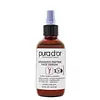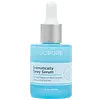What's inside
What's inside
 Key Ingredients
Key Ingredients

 Benefits
Benefits

 Concerns
Concerns

 Ingredients Side-by-side
Ingredients Side-by-side

Aloe Barbadensis Leaf Juice
Skin ConditioningWater
Skin ConditioningHyaluronic Acid
HumectantXanthan Gum
EmulsifyingPyrus Malus Fruit Extract
Skin ConditioningGlycerin
HumectantOryza Sativa Bran Extract
Skin ConditioningCaprylic/Capric Triglyceride
MaskingCetearyl Olivate
Sorbitan Olivate
EmulsifyingCetyl Palmitate
EmollientSorbitan Palmitate
EmulsifyingButyrospermum Parkii Butter
Skin ConditioningArgania Spinosa Kernel Oil
EmollientStearyl Glycyrrhetinate
Skin ConditioningCetyl Alcohol
EmollientCI 52015
Copper Tripeptide-1
Skin ConditioningMacrocystis Pyrifera Extract
Skin ConditioningGlycyrrhiza Glabra Root Extract
BleachingNiacinamide
SmoothingResveratrol
AntioxidantMalus Domestica Fruit Cell Culture Extract
Skin ConditioningLecithin
EmollientPisum Sativum Peptide
Skin ConditioningLeuconostoc/Radish Root Ferment Filtrate
AntimicrobialPropanediol
SolventChlorella Vulgaris Extract
Skin ConditioningLactic Acid
BufferingCollagen
MoisturisingTetrasodium Glutamate Diacetate
Phenoxyethanol
PreservativeCaprylhydroxamic Acid
Caprylyl Glycol
EmollientAloe Barbadensis Leaf Juice, Water, Hyaluronic Acid, Xanthan Gum, Pyrus Malus Fruit Extract, Glycerin, Oryza Sativa Bran Extract, Caprylic/Capric Triglyceride, Cetearyl Olivate, Sorbitan Olivate, Cetyl Palmitate, Sorbitan Palmitate, Butyrospermum Parkii Butter, Argania Spinosa Kernel Oil, Stearyl Glycyrrhetinate, Cetyl Alcohol, CI 52015, Copper Tripeptide-1, Macrocystis Pyrifera Extract, Glycyrrhiza Glabra Root Extract, Niacinamide, Resveratrol, Malus Domestica Fruit Cell Culture Extract, Lecithin, Pisum Sativum Peptide, Leuconostoc/Radish Root Ferment Filtrate, Propanediol, Chlorella Vulgaris Extract, Lactic Acid, Collagen, Tetrasodium Glutamate Diacetate, Phenoxyethanol, Caprylhydroxamic Acid, Caprylyl Glycol
Water
Skin ConditioningLonicera Caprifolium Flower Extract
PerfumingLonicera Japonica Flower Extract
Skin ConditioningCitric Acid
BufferingXanthan Gum
EmulsifyingGlycerin
HumectantAloe Barbadensis Leaf Extract
EmollientSodium Hyaluronate
HumectantHyaluronic Acid
HumectantPotassium Cetyl Phosphate
EmulsifyingCetearyl Alcohol
EmollientCetyl Palmitate
EmollientSorbitan Palmitate
EmulsifyingSorbitan Oleate
EmulsifyingHydrogenated Ethylhexyl Olivate
EmollientHydrogenated Olive Oil Unsaponifiables
EmollientCaprylic/Capric Triglyceride
MaskingOryza Sativa Bran Extract
Skin ConditioningRosmarinus Officinalis Leaf Extract
AntimicrobialHelianthus Annuus Seed Extract
Skin ConditioningPullulan
Hydrolyzed Hyaluronic Acid
HumectantPotassium Sorbate
PreservativeSodium Acrylate/Sodium Acryloyldimethyl Taurate Copolymer
Emulsion StabilisingPolyisobutene
Caprylyl Glucoside
CleansingPanthenol
Skin ConditioningErythritol
HumectantHibiscus Esculentus Fruit Extract
Skin ConditioningPelargonium Graveolens Flower Oil
MaskingWater, Lonicera Caprifolium Flower Extract, Lonicera Japonica Flower Extract, Citric Acid, Xanthan Gum, Glycerin, Aloe Barbadensis Leaf Extract, Sodium Hyaluronate, Hyaluronic Acid, Potassium Cetyl Phosphate, Cetearyl Alcohol, Cetyl Palmitate, Sorbitan Palmitate, Sorbitan Oleate, Hydrogenated Ethylhexyl Olivate, Hydrogenated Olive Oil Unsaponifiables, Caprylic/Capric Triglyceride, Oryza Sativa Bran Extract, Rosmarinus Officinalis Leaf Extract, Helianthus Annuus Seed Extract, Pullulan, Hydrolyzed Hyaluronic Acid, Potassium Sorbate, Sodium Acrylate/Sodium Acryloyldimethyl Taurate Copolymer, Polyisobutene, Caprylyl Glucoside, Panthenol, Erythritol, Hibiscus Esculentus Fruit Extract, Pelargonium Graveolens Flower Oil
 Reviews
Reviews

Ingredients Explained
These ingredients are found in both products.
Ingredients higher up in an ingredient list are typically present in a larger amount.
This ingredient is an emollient, solvent, and texture enhancer. It is considered a skin-softener by helping the skin prevent moisture loss.
It helps thicken a product's formula and makes it easier to spread by dissolving clumping compounds.
Caprylic Triglyceride is made by combining glycerin with coconut oil, forming a clear liquid.
While there is an assumption Caprylic Triglyceride can clog pores due to it being derived from coconut oil, there is no research supporting this.
Learn more about Caprylic/Capric TriglycerideCetyl Palmitate is a wax-like substance.
It comes from palmitic acid and palmityl alcohol. Cetyl Palmitate may not be safe for Malassezia folliculitis, or fungal-acne.
This ingredient is naturally found in the guava fruit and stony corals.
Learn more about Cetyl PalmitateGlycerin is already naturally found in your skin. It helps moisturize and protect your skin.
A study from 2016 found glycerin to be more effective as a humectant than AHAs and hyaluronic acid.
As a humectant, it helps the skin stay hydrated by pulling moisture to your skin. The low molecular weight of glycerin allows it to pull moisture into the deeper layers of your skin.
Hydrated skin improves your skin barrier; Your skin barrier helps protect against irritants and bacteria.
Glycerin has also been found to have antimicrobial and antiviral properties. Due to these properties, glycerin is often used in wound and burn treatments.
In cosmetics, glycerin is usually derived from plants such as soybean or palm. However, it can also be sourced from animals, such as tallow or animal fat.
This ingredient is organic, colorless, odorless, and non-toxic.
Glycerin is the name for this ingredient in American English. British English uses Glycerol/Glycerine.
Learn more about GlycerinHyaluronic acid is naturally found in healthy skin. It is a humectant, meaning it draws moisture to your skin.
This ingredient helps hydrate, soothe, and protect the skin.
What makes hyaluronic acid so hydrating? It has the capacity to bind or hold large amounts of water.
Fun fact: It is already naturally found in our bodies, such as the fluids of our eyes and our joints.
Studies find this ingredient to have anti-inflammatory and anti-microbial properties. This can help speed up wound-healing.
Hyaluronic acid can be irritating if the molecule has a low-molecular weight, or if the molecules are small.
One study found low-molecular weight hyaluronic acid to be pro-inflammatory, meaning some people may experience irritation. This is because our bodies use hyaluronic acid in the wound-healing process to signal to our bodies, via irritation, that something needs healing.
The same study found high-molecular weight hyaluronic acid to be anti-inflammatory.
These are some other common types of Hyaluronic Acid:
Learn more about Hyaluronic AcidOryza Sativa Bran Extract comes from the outer layer of a rice kernel. It is a byproduct of milling rice, or the operation to produce a whole grain rice product.
This ingredient has moisturizing properties due to its components of polysaccharides and omega-3 fatty acids. It also contains calcium, selenium, phosphorus, iron, and zinc.
Oryza Sativa Bran Extract contains numerous antioxidants such as ferulic acid. Antioxidants help fight free-radical molecules. Free-radical molecules are capable of damaging our cells and other genetic material.
Learn more about Oryza Sativa Bran ExtractSorbitan Palmitate is an emulsifier.
It is created by reacting sorbitol with palmitic acid.
Water. It's the most common cosmetic ingredient of all. You'll usually see it at the top of ingredient lists, meaning that it makes up the largest part of the product.
So why is it so popular? Water most often acts as a solvent - this means that it helps dissolve other ingredients into the formulation.
You'll also recognize water as that liquid we all need to stay alive. If you see this, drink a glass of water. Stay hydrated!
Learn more about WaterXanthan gum is used as a stabilizer and thickener within cosmetic products. It helps give products a sticky, thick feeling - preventing them from being too runny.
On the technical side of things, xanthan gum is a polysaccharide - a combination consisting of multiple sugar molecules bonded together.
Xanthan gum is a pretty common and great ingredient. It is a natural, non-toxic, non-irritating ingredient that is also commonly used in food products.
Learn more about Xanthan Gum